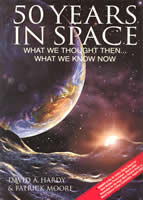If you put renowned space artist David Hardy and legendary astronomy writer Patrick Moore together, you’d expect something fairly special…and that is what you get with this book. The fact that “50 Years in Space” is based, not on the fifty-odd years of the Space Age, but on the period 1954-2004 is of no concern. It simply marks the period over which (at first publication) the authors had worked together.
Following a brief introduction, the book is divide into 25 sections covering the planets and other astronomical objects. In general, the format contrasts the accepted view of these objects in the late 1950s with the evolution of that view towards the 21st century. As the subtitle suggests, it is somewhat autobiographical in this regard.
However, with due respect to Patrick’s illuminating text, it is the images that make this book. From a vision of the Moon that owes much to the late Chesley Bonestell to a more modern rendition, and from Mars with a blue sky to one of shocking pink, we see how actual data feeds the artist’s inspiration (not to mention the need to update his paintings!). Of course, close-up views of black holes and supernovae will always require a degree of artistic license, but the images are no less impressive for it.
One of the interesting notes made by Hardy is the way his method of working has progressed in step with the way planetary images are collected: “Just as the images from space are now often gathered or processed electronically or digitally, many of the new illustrations for this book were produced on an AppleMac”. As if to assure the more conservative reader, he attempts to present an equivalence: “pushing paint around on art board or canvas has mainly been replaced by pushing pixels around on a monitor!”. To be honest, the difference is probably not readily apparent to most readers, because Hardy’s distinctive style shines through.
All space fans should have at least one space art book on their shelves…and there is no reason why it shouldn’t be this one.


